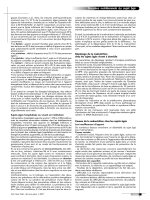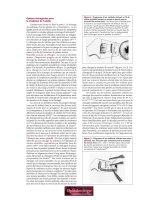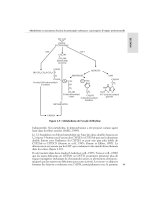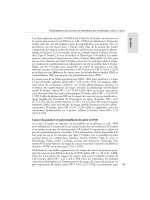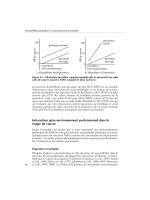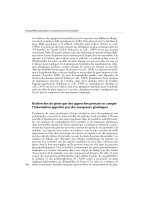Susceptibilités génétiques et expositions professionnelles - part 9 pot
Bạn đang xem bản rút gọn của tài liệu. Xem và tải ngay bản đầy đủ của tài liệu tại đây (253.25 KB, 15 trang )
responsable des réactions allergiques (Maslinski et Fogel, 1991). Il a été
montré que l’activité de l’enzyme NAT2 était importante dans la régulation
de la libération de l’histamine (Scheuch et coll., 1996). Des comparaisons cas
(allergiques)/témoins (non allergiques) ont mis en évidence une fréquence
plus élevée des génotypes correspondant au phénotype « acétyleur lent » chez
des sujets allergiques ayant des manifestations cliniques différentes (Zieliska et
coll., 1997 ; Gawroska et coll., 1999). Deux autres études, l’une chez des sujets
ayant une allergie cutanée à la p-phénylènediamine (Kawakubo et coll.,
1997), composé souvent présent dans la teinture des cheveux, et l’autre chez
des sujets ayant des réactions d’hypersensibilité aux sulfonamides (Rieder et
coll., 1991), ont confirmé l’association du phénotype « acétyleur lent » avec
l’allergie. En revanche, le phénotype « acétyleur rapide » a été plus fréquem-
ment observé chez des sujets ayant une allergie de contact, sensibilisés aux
composés aryl para-substitués (Schnuch et coll., 1998). Deux hypothèses
étaient émises pour cette dernière observation : ou bien l’acétylation de ces
composés chimiques augmente la sensibilisation des sujets (hypothèse fonc-
tionnelle), ou bien le génotype NAT2 est l’un des facteurs génétiques augmen-
tant la susceptibilité aux allergies de contact.
Les études de pharmacogénétique sont un autre exemple d’interaction entre
susceptibilité génétique et réponse à un agent extérieur (médicament). Des
études récentes ont montré qu’un polymorphisme du gène du récepteur b2
adrénergique (Gln/Glu 27) influence la réactivité bronchique après un traite-
ment prolongé aux b2-agonistes (Hall et coll., 1995) et qu’un variant dans la
région promotrice du gène 5-lipoxygénase (ALOX5), qui intervient dans le
métabolisme des leucotriènes, influence la réponse à des inhibiteurs de ce gène
(Drazen et coll., 1998).
En conclusion, si les avancées dans le domaine de la génétique moléculaire
combinées aux développements des méthodes statistiques ont permis de met-
tre en évidence plusieurs régions du génome impliquées dans l’asthme et
l’atopie, il reste à franchir plusieurs étapes avant d’élucider les mécanismes
physiopathologiques à l’origine de ces maladies complexes. De multiples gènes
de susceptibilité semblent intervenir, certains d’entre eux pouvant avoir un
effet pléïotropique sur différents phénotypes et un même phénotype pouvant
lui-même être déterminé par plusieurs gènes. Des résultats positifs obtenus
dans des populations ne sont pas confirmés dans d’autres. Cette discordance
des résultats peut en partie s’expliquer par une définition différente des phé-
notypes étudiés, un mode de recensement différent des données (aléatoire, par
des sujets asthmatiques ou atopiques), des différences entre origines ethniques
des populations étudiées soumises à des environnements différents, et aussi le
caractère complexe et hétérogène de ces pathologies. Les études d’association
ont suggéré un rôle de plusieurs variants génétiques mais la démonstration de
leur implication fonctionnelle doit être faite. La caractérisation des détermi-
nants génétiques fonctionnels de l’asthme et des phénotypes associés pourra
Facteurs de susceptibilité génétique dans l’asthme
115
ANALYSE
conduire à mieux comprendre les interactions entre les facteurs de susceptibi-
lité génétique et de l’environnement, pouvant intervenir comme facteurs
étiologiques ou éléments aggravants des manifestations cliniques de la mala-
die.
Les progrès dans l’identification des gènes de susceptibilitéàl’asthme et
l’allergie nécessitent des ressources importantes incluant la mise en commun
de grands échantillons de données familiales, le développement de techniques
de génotypage et de séquençage des gènes encore plus performantes ainsi que
le développement de méthodes statistiques plus générales intégrant les effets
de plusieurs gènes et de facteurs de l’environnement agissant sur plusieurs
phénotypes corrélés. C’est l’identification de ces gènes et la compréhension de
leurs interactions avec les facteurs de l’environnement qui pourra conduire à
mieux définir les groupes de sujets à risque et à développer les thérapeutiques
adaptées aux mécanismes moléculaires de ces pathologies.
B
IBLIOGRAPHIE
BALDINI M, LOHMAN IC, HALONEN M, ERICKSON RP, HOLD PG, MARTINEZ FD. A poly-
morphism in the 5’flanking region of the CD14 gene is associated with circulating
soluble CD14 levels and with total serum immunoglobulin E. Am J Respir Cell Mol
Biol 1999, 20 : 976-983
BARNES KC, FREIDHOFF LR, NICKEL R, CHIU YF, JUO SH et coll. Dense mapping of
chromosome 12q13.12-q23.3 and linkage to asthma and atopy. J Allergy Clin Immunol
1999, 104 : 485-491
BARNES KC, NEELY JD, DUFFY DL, FREIDHOFF LR, BREAZEALE DR et coll. Linkage of
asthma and total serum IgE concentration to markers on chromosome 12q : evidence
from afro-caribbean and caucasian populations. Genomics 1996, 37 : 41-50
BIGNON JS, ARON Y, JU LY, KOPFERSCHMITT MC, GARNIER R et coll. HLA class II alleles
in isocyanate-induced asthma. Am J Resp Crit Care Med 1994, 149 : 71-75
BOEHNCKE WH, LOELIGER C, KUEHNL P, KALBACHER H, BÖHM BO, GALL H. Identifica-
tion of HLA-DR and – DQ alleles conferring susceptibility to pollen allergy and
pollen associated food allergy. Clin Exp Allergy 1998, 28 : 434-441
BONNEY GE. On the statistical determination of major gene mechanisms in continu-
ous human traits : regressive models. Am J Med Genet 1984, 18 : 731-749
BONNEY GE. Regressive logistic models for familial diseases and other binary traits.
Biometrics 1986, 42 : 611-625
BURCHARD EG, SILVERMAN EK, ROSENWASSER LJ BORISH L, YANDAVA C et coll. Asso-
ciation between a sequence variant in the IL-4 gene promoter and FEV(1) in asthma.
Am J Respir Crit Care Med 1999, 160 : 919-922
BURROWS B. Allergy and the development of asthma and bronchial hyperresponsive-
ness. Clin Exp Allergy 1995, 25 : 15-16
Susceptibilitésgénétiques et expositions professionnelles
116
CAMPBELL DA, LI KAM WA E, BRITTON J, HOLGATE ST, MARKHAM AF, MORRISON JF.
Polymorphism at the tumour necrosis factor locus and asthma. Monogr Allergy 1996,
33 : 125-137
CHAGANI T, PARE PD, ZHU S, WEIR TD, BAI TR et coll. Prevalence of tumor necrosis
factor-x and angiotensin converting enzyme polymorphisms in mild/moderate and
fatal/near-fatal asthma. Am J Respir Crit Care Med 1999, 160 : 278-282
CHOUCHANE L, SFAR I, BOUSAFFARA R, EL KAMEL A, SFAR MT, ISMAIL A. A repeat
polymorphism in interleukin-4 gene is highly associated with specific clinical pheno-
types of asthma. Int Arch Allergy Immunol 1999, 120 : 50-55
COOKSON WO, SHARP PA, FAUX JA, HOPKIN JM. Linkage between immunoglobulin E
responses underlying asthma and rhinitis and chromosome 11q. Lancet 1989, 1:
1292-1295
COOKSON WO, YOUNG RP, SANDFORD AJ, MOFFATT MF, SHIRAKAWA T et coll. Maternal
inheritance of atopic IgE responsiveness on chromosome 11q. Lancet 1992, 340 :
381-384
COOKSON W. The genetics of asthma. In : Genetic approaches to noncommunicable
diseases.
BERG K, BOULYJENKOV V, CHRISTEN Y Eds. Springer-Verlag, 1996, 79-96
COOKSON W. The alliance of genes and environment in asthma and allergy. Nature
1999, 402 : B5-B11
COX HE, MOFFATT MF, FAUX JA, WALLEY AJ, COLEMAN R et coll. Association of atopic
dermatitis to the beta subunit of the high affinity immunoglobulin E receptor. Br J
Dermatol 1998, 138 : 182-187
CSGA (The Collaborative Study on the Genetics of Asthma). A genome-wide search for
asthma susceptibility genes loci in ethnically diverse populations. Nature Genetics
1997, 15 : 389-392
D’AMATO M, SCOTTO D’ABUSCO A, MAGGI E, MENNA T, SACERDOTI G et coll. Associa-
tion of responsiveness to the major pollen allergen of Parietaria officinalis with HLA-
DRB1* alleles : a multicenter study. Human Immunol 1996, 46 : 100-106
D’AMATO M, VITIANI LR, PETRELLI G, FERRIGNO L, DI PIETRO A et coll. Association of
persistent bronchial hyperresponsiveness with b
2
-adrenoceptor (ADRB2) haplo-
types. Am J Respir Crit Med 1998, 158 : 1968-1973
DANIELS SE, BHATTACHARRYA S, JAMES A, LEAVES NI, YOUNG A etcoll.Agenome wide
search for quantitative trait loci underlying asthma. Nature 1996, 383 : 247-250
DEICHMANN KA, STARKE B, SCHLENTHER S, HEINZMANN A, SPARHOLT SH et coll.
Linkage and association studies of atopy and the chromosome 11q13 region. J Med
Genet 1999, 36 : 379-382
DEICHMANN K, BARDUTZKY J, FORSTER J, HEINZMANN A, KUEHR J. Common polymor-
phisms in the coding part of the IL-4 receptor gene. Biochem Biophys Res Comm 1997,
231 : 696-697
DEICHMANN KA, HEINZMANN A, FORSTER J, DISCHINGER S, MEHL C etcoll. Linkage and
allelic association of atopy and markers flanking the IL4-receptor gene. Clin Exp
Allergy 1998, 28 : 151-155
Facteurs de susceptibilité génétique dans l’asthme
117
ANALYSE
DEKKER JM, NIZANKOWSKA E, SCHMITZ-SCHUMANN M, PILE K, BOCHENEK G et coll.
Aspirin-induced asthma and HLA-DRB1 and HLA-DPB1 genotypes. Clin Exp Al-
lergy 1997, 27 : 574-577
DEMENAIS F, MURIGANDE C, BONNEY GE. Search for faster methods of fitting regressive
models to quantitative traits. Genet Epidemiol 1990, 7:319-334
DEMENAIS F, LAING AE, BONNEY GE. Numerical comparisons of two formulations of the
regressive models with the mixed model in segregation analysis of discrete traits.
Genet Epidemiol 1992, 9:419-435
DEWAR JC, WILKINSON J, WHEATLEY A, THOMAS NS, DOULL I et coll. The glutamine
27 beta2-adrenoceptor polymorphism is associated with elevated IgE levels in asth-
matic families. J Allergy Clin Immunol 1997, 100 : 261-265
DIZIER MH, BESSE-SCHMITTLER C, GUILLOUD-BATAILLE M, ANNESI-MAESANO I, BOUS-
SAHA M
et coll. Genome screen for asthma and related phenotypes in the French
EGEA study. Am J Resp Crit Care Med 2000, 162 : 1812-1818
DIZIER MH, JAMES A, FAUX J, MOFFAT MF, MUSK AW et coll. Segregation analysis of the
specific response to allergens : a recessive major gene controls the specific IgE response
to Timothy Grass Pollen. Genet Epidemiol 1999a, 16 : 305-315.
DIZIER MH, SANDFORD A, WALLEY A, PHILIPPI A, COOKSON W, DEMENAIS F.Indication of
linkage of serum IgE levels to the interleukin-4 gene and exclusion of the contribu-
tion of the (– 590 C to T) interleukin-4 promoter polymorphism to IgE variation.
Genet Epidemiol 1999b, 16 : 84-94
DOULL IJ, LAWRENCE S, WATSON M, BEGISHVILI T, BEASLEY RW et coll. Allelic associa-
tion of gene markers on chromosomes 5q and 11q with atopy and bronchial hyperre-
sponsiveness. Am J Resp Crit Care Med 1996, 153 : 1280-1284
DRAZEN JM, YANDAVA CN, DUBE L, SZCZERBACK N, HIPPENSTEEL R et coll. Pharmacoge-
netic association between ALOX5 promoter genotype and the response to anti-
asthma treatment. Nat Genet 1999, 22 : 168-170
FISCHER GF, PICKL WF, FAE I, EBNER C, FERREIRA F et coll. Association between IgE
response against Bet v I, the major allergen of birch pollen, and HLA-DRB alleles.
Hum Immunol 1992, 33 : 259-265
GAO PS, MAO XQ, KAWAI M, ENOMOTO T, SASAKI S et coll. Negative association
between asthma and variants of CC16 (CC10) on chromosome 11q13 in british and
japanese populations. Hum Genet 1998, 103 : 57-59
GAO PS, KAWADA H, KASAMATSU T, MAO XQ, ROBERTS MH et coll. Variants of NOS1,
NOS2 and NOS3 genes in asthmatics. Biochem Biophys Res Comm 2000, 267 : 761-
763
GAWRONSKA-SZKLARZ B, LUSZAWSKA-KUTRZEBA T, CZAJA-BULSA G, KURZAWSKI G.
Relationship between acetylation polymorphism and risk of atopic diseases. Clin
Pharmacol Ther 1999, 65 : 562-569
GRASEMAN H, YANDAVA CN, DRAZEN JM. Neuronal NO synthase (NOS1) is a major
candidate gene for asthma. Clin Exp Allergy 1999, 29 : 39-41
GREEN SA, TURKI J, BEJARANO P, HALL IP, LIGGETT SB.Influence of b
2
-adrenergic
receptor genotypes on signal transduction in human smooth airway muscle cells. Am
J Respir Cell Mol Biol 1995, 13 : 25-33
Susceptibilitésgénétiques et expositions professionnelles
118
GREEN SA, TURKI J, INNIS M, LIGGETT SB. Amino-terminal polymorphisms of the
human b
2
-adrenergic receptor impart distinct agonist-promoted regulatory properties.
Biochemistry 1994, 33 : 9414-9419
GRUNIG W, WARNOCK M, WAKIL AE, VENKAYYA R, BROMBACHER F, RENNICK DM. Re-
quirement for IL-13 independently of IL-4 in experimental asthma. Science 1998,
282 : 2261-2263
HALL IP, WHEATLEY A, WILDING P, LIGGETT SB. Association of Glu 27 beta
2-adrenoceptor polymorphism with lower airway reactivity in asthmatic subjects.
Lancet 1995, 345 : 1213-1214
HANSON B, MCGUE M, ROITMAN-JONSHON B, SEGAL NL, BOUCHARD TJ, BLUMENTHAL
NIN
. Atopic disease and immunoglobulin E in twins reared apart and together. Am J
Hum Genet 1991, 48 : 873-879
HEINZMANN A, MAO XQ, AKAIWA M, KREOMER RT, GAO PS et coll. Genetic variants of
IL-13 signalling and human asthma and atopy. Hum Mol Genet 2000,9:549-559
HERSHEY GKK, FRIEDRICH MF, ESSWEIN LA, THOMAS ML, CHATILA TA. The association
of atopy with a gain-of-function mutation in the a subunit of the interleukin-
4 receptor. New Engl J Medicine 1997, 37 : 1720-1728
HILL MR, JAMES AL, FAUX JA, RYAN G, HOPKIN JM et coll. FceRI-b polymorphism and
risk of atopy in a general population sample. Br Med J 1995, 311 : 776-779
HILL MR, COOKSON WO. A new variant of the b subunit of the high-affinity receptor
for immunoglobulin E (FceRI-b E237G) : Associations with measures of atopy and
bronchial hyperresponsiveness. Hum Mol Genet 1996, 5:959-962
HIZAWA N, FREIDHOFF LR, CHIU YF, EHRLICH E, LUEHR CA et coll. The Collaborative
Study on the Genetics of Asthma (CSGA). Genetic regulation of Dermatophagoides
pteronyssinus specific IgE responsiveness : a genome-wide multipoint linkage analysis
in families recruited through 2 asthmatic sibs. J Allergy Clin Immunol 1998a,
102 : 436-442
HIZAWA N, FREIDHOFF LR, EHRLICH E, CHIU YF, DUFFY DL et coll. Genetic influences of
chromosomes 5q31-q33 and 11q13 on specific IgE responsiveness to common inhaled
allergens among african american families. Collaborative Study on the Genetics of
Asthma (CSGA). J Allergy Clin Immunol 1998b, 102 : 449-453
HOLBERG CJ, ELSTON RC, HALONEN M, WRIGHT AL, TAUSSIG LM et coll. Segregation
analysis of physician-diagnosed asthma in hispanic and non hispanic white families.
Am J Resp Crit Care Med 1996, 154 : 144-150
HOLBERG CJ, HALONEN M, WRIGHT AL, MARTINEZ FD. Familial aggregation and segre-
gation analysis of eosinophil levels. Am J Resp Crit Care Med 1999, 5:1604-1610
HOPP RJ, BEWTRA AK, WATT GD, NAIR NM, TOWNLEY RG. Genetic analysis of allergic
disease in twins. J Allergy Clin Immunol 1984, 73 : 265-270
HOWELL WM, HOLGATE ST. Human leukocyte antigen genes and allergic disease.
Monogr Allergy 1996, 33 : 53-70
ISHII N, TAKAHASHI K, KAWAGUCHI H, NAKAJIMA H, TANAKA S, AOKI I. Genetic con-
trol of delayed-type hypersensitivity to chromium chloride. Int Arch Allergy Immunol
1993, 100 : 333-337
Facteurs de susceptibilité génétique dans l’asthme
119
ANALYSE
JENKINS MA, HOPPER JL, GILES GG. Regressive logistic modeling of familial aggregation
for asthma in 7,934 population-based nuclear families. Genet Epidemiol 1997,
14 : 317-332
KAUFFMANN F, DIZIER MH, PIN I, PATY E, GORMAND F et coll. Epidemiological study of
the genetics and environment of asthma, bronchial hyperresponsiveness, and atopy :
phenotype issues. Am J Respir Crit Care Med 1997, 156 : S123-S129
KAUFFMANN F, DIZIER MH, ANNESI-MAESANO I, BOUSQUET J, CHARPIN D et coll. EGEA
(Epidemiological study on the Genetics and Environment of Asthma, bronchial
responsiveness and atopy) – Descriptive characteristics. Clin Exp Allergy 1999, 29 :
17-22
KAWAKUBO Y, NAKAMORI M, SCHOPF E, OHKIDO M. Acetylator phenotype in patients
with p-phenylenediamine allergy. Dermatology 1997, 195 : 43-45
KAWASHIMA T, NOGUCHI E, ARINAMI T, YAMAKAWA-KOBAYASHI K, NAKAGAWA H et
coll. Linkage and association of an interleukin-4 gene polymorphism with atopic
dermatitis in japanese families. J Med Genet 1998, 35 : 502-504
KRUGLYAK L, LANDER ES. Complete multipoint sib-pair analysis of qualitative and
quantitative traits. Am J Hum Genet 1995, 57 : 439-454
KRUSE S, JAPHA T, TEDNER M, SPARHOLT SH, FORSTER J et coll. The polymorphisms
S503P and Q576R in the interleukin-4 receptor a gene are associated with atopy and
influence the signal transduction. Immunology 1999, 96 : 365-371
LAING IA, GOLDBLATT J, EBER E. A polymorphism of the CC16 gene is associated with
an increased risk of asthma. J Med Genet 1998, 35 : 463-467
LALOUEL JM, RAO DC, MORTON NE, ELSTON RC. A unified model for complex segrega-
tion analysis. Am J Hum Genet 1983, 35 : 816-826
LANDER ES, KRUGLYAK L. Genetic dissection of complex traits : guidelines for inter-
preting and reporting linkage results. Nature Genetics 1995, 11 : 241-244
LAWRENCE S, BEASLEY R, DOULL I, BEGISHVILI B, LAMPE F et coll. Genetic analysis of
atopy and asthma as quantitative traits and ordered polychotomies. Ann Hum Genet
1994, 58 : 359-368
LEVINE BB, STEMBER RH, FOTINO M. Ragweed hayfever : genetic control and linkage to
HL-A haplotypes. Science 1972, 178 : 1201-1203
LI KAM WA TC, MANSUR AH, BRITTON J, WILLIAMS G, PAVORD I et coll. Association
between - 308 tumour necrosis factor promoter polymorphism and bronchial hyperre-
activity in asthma. Clin Exp Allergy 1999, 29 : 1204-1208
LOS H, KOPPELMAN GH, POSTMA DS. The importance of genetic influence in asthma.
Eur Resp J 1999, 14 : 1210-1227
MANSUR AH, BISHOP DT, MARKHAM AF, MORTON NE, HOLGATE ST, MORRISON JFJ.
Suggestive evidence for genetic linkage between IgE phenotypes and chromosome
14q markers. Am J Respir Crit Care Med 1999, 159 : 1796-1802
MAO XQ, SHIRAKAWA T, SASAKI S, ENOMOTO T, MORIMOTO K, HOPKIN JM. Maternal
inheritance of atopy at the Fc epsilon RI beta locus in japanese sibs. Hum Hered 1997,
47 : 173-180
Susceptibilitésgénétiques et expositions professionnelles
120
MARSH DG, BLUMENTHAL MN, ISHIKAWA T, RUFFILLI A, SPARHOLT S, FREIDHOFF LR.
HLA and specific immune responsiveness to allergens. In : HLA and specific immune
responsiveness to allergens. TSUJI K, AIZAWA M, SASAZUKI T Eds. Oxford, UK : Oxford
University Press 1992, 1:765
MARSH DG, NEELY JD, BREAZEALE DR, GHOSH B, FREIDHOFF LR et coll. Linkage analysis
of IL4 and other chromosome 5q31.1 markers and total serum immunoglobulin E
concentrations. Science 1994, 264 : 1152-1156
MARTINATI LC, TRABETTI E, CASARTELLI A, BONER AL, PIGNATTI PF. Affected sib-pair
and mutation analyses of the high affinity IgE receptor beta chain locus in Italian
families with atopic asthmatic children. Am J Respir Crit Care Med 1996, 153 :
1682-1685
MARTINEZ FD, GRAVES PE, BALDINI M, SOLOMON S, ERICKSON R. Association between
genetic polymorphisms of the b
2
-adrenergic receptor and response to albuterol in
children with and without a history of wheezing. J Clin Invest 1997, 100 : 3184-3188
MARTINEZ FD, SOLOMON S, HOLBERG CJ, GRAVES PA, BALDINI M, ERICKSON RP. Linkage
of circulating eosinophils to markers on chromosome 5. Am J Resp Crit Care Med
1998, 158 : 1739-1744
MASLINSKI C, FOGEL A. Catabolism of histamine. In : Handbook of experimental
pharmacology : histamine and histamine antagonists.
UVÄNS B ed. Berlin : Springer-
Verlag, 1991, 1997, p 165-189
MASON DA, MOORE JD, GREEN SA, LIGGETT SB. A gain-of-function mutation in the
G-protein coupled domain of the human betal-adrenergic receptor. J Biol Chem 1999,
18 : 12670-12674
MCGRAW DW, FORBES SL, KRAMER LA, LIGGETT SB. Polymorphisms of the 5’ leader
ciston of the human beta2-adrenergic receptor regulate receptor expression. J Clint
Invest 1998, 102 : 1927-1932
MEUNIER F, DIZIER MH, HOCHEZ J, FEINGOLD J, DEMENAIS F. Familial aggregation of skin
prick tests to common allergens in 335 French families of the EGEA study. Am J Resp
Crit Care Med 1999, A649
MEUNIER F, DIZIER MH, BESSE-SCHMITTLER C, GUILLOUD-BATAILLE M, ANNESI-
MAESANO I et coll. Genome-wide search for specific response to allergens in the
French EGEA study. Am J Resp Crit Care Med 2000, 161 : A600
MEYERS DA, POSTMA DS, PANHUYSEN CI, XU J, AMELUNG PJ et coll. Evidence for a locus
regulating total serum IgE levels mapping to chromosome 5. Genomics 1994, 23 :
464-470
MITSUYASU H, IZUHARA K, MAO XQ, GAO PS, ARINOBU Y et coll. Ile50Val variant of
IL4Ra upregulates IgE synthesis and associates with atopic asthma. Nature Genet
1998, 19 : 119-120
MOFFATT MF, HILL MR, CORNELIS F, SCHOU C, FAUX JA et coll. Genetic linkage of T-cell
receptor alpha/delta complex to specific IgE responses. Lancet 1994, 343 : 1597-1600
MOFFATT MF, COOKSON WO. The genetics of specific allergy. In : The genetics of
specific allergy. HALL IP Ed. Book. Basel : Karger Press 1996, 33 : 71
MOFFATT MF, COOKSON WO. Tumour necrosis factor haplotypes and asthma. Hum Mol
Genet 1997, 6:551-554
Facteurs de susceptibilité génétique dans l’asthme
121
ANALYSE
MOFFATT MF, SCHOU C, FAUX JA, COOKSON WOCM. Germline TCR-A restriction of
immunoglobulin E responses to allergen. Immunogenetics 1997, 46 : 226-230
MOFFATT MF, COOKSON WO. The genetics of asthma. Maternal effects in atopic
disease. Clin Exp Allergy 1998, 28 : 56-61
MOFFATT MF, JAMES A, RYAN G, MUSK AW, COOKSON WO. Extended tumour necrosis
factor/HLA-DR haplotypes and asthma in an australian population sample. Thorax
1999, 54 : 757-761
NEUKIRCH F, PIN I, KNANI J, HENRY C, PISON C et coll. Prevalence of asthma-like
symptoms in three French cities. Resp Med 1995, 89 : 685-689
NEWMAN-TAYLOR A. Environmental determinants of asthma. Lancet 1995, 345 : 296-
299
NICKEL R, WAHN U, HIZAWA N, MAESTRI N, DUFFY DL et coll. Evidence for linkage of
chromosome 12 q15-q24.1 markers to total serum IgE concentrations in children of
the German multicenter allergy study. Genomics 1997, 46 : 159-162
NIELSEN J, JOHNSON U, WELINDER H, BENSRYD I, RYLANDER L, SKERFVING S. HLA and
immune nonresponsiveness in workers exposed to organic acid anhydrides. J Occup
Environ Med 1996, 38 : 1087-1090
NOGUCHI E, SHIBASAKI M, ARINAMI T, TAKEDA K, MAKI T et coll. Evidence for linkage
between asthma/atopy in childhood an chromosome 5q31-q33 in a Japanese popula-
tion. Am J Resp Crit Care Med 1997, 156 : 1390-1393
NOGUCHI E, SHIBASAKI M, ARINAMI T, TAKEDA K, KOBAYASHI K et coll. Evidence for
linkage between the development of asthma in childhood and the T-cell receptor b
chain gene in Japanese. Genomics 1998, 47 : 121-124
NOGUCHI E, SHIBASAKI M, ARINAMI T, TAKEDA K, YOKOUCHI Y et coll. No association
between atopy/asthma and the Ile50Val polymorphism of IL-4 receptor. Am J Respir
Crit Care Med 1999, 160 : 342-345
OBER C, COX NJ, ABNEY M, DI RIENZO A, LANDER ES et coll. The Collaborative Study on
the Genetics of Asthma. Genome-wide susceptibility loci in a founder population.
Hum Mol Genet 1998, 7:1393-1398
OBER C, TSALENKO A, WILLADSEN S NEWMAN D, DANIEL X et coll. Genome-wide screen
for atopy susceptibility alleles in the Hutterites. Clin Exp Allergy 1999, 29 : S11-S15
OBER C, LEAVITT SA, TSALENKO A, HOWARD TD, HOKI DM et coll. Variation in the
interleukin 4-receptor alpha gene confers susceptibility to asthma and atopy in
ethnically diverse populations. Am J Hum Genet 2000, 66 : 517-526
PALMER LJ, DANIELS WE, RYE PJ, GIBSON NA, TAY GK et coll. Linkage of chromosome 5q
and 11q gene markers to asthma-associated quantitative traits in australian children.
Am J Respir Crit Care Med 1998, 158 : 1825-1830
PALMER LJ, RYE PJ, GIBSON NA, MOFFAT MF, GOLDBLATT J et coll. Association of
FCeRI-b polymorphisms with asthma and associated traits in australian asthmatic
families. Clin Exp Allergy 1999, 29 : 1555-1562
PANHUYSSEN CIM, MEYERS DA. Genetic regulation of total serum IgE levels. In :
Genetics of asthma. Marcel Dekker Inc, New York, 1996, p 511-523
Susceptibilitésgénétiques et expositions professionnelles
122
POSTMA DS, BLECKER ER, AMELUNG PJ, HOLROYD KJ, XU J et coll. Genetic susceptibility
to asthma-bronchial responsiveness coinherited with a major gene for atopy. New
Engl J Med 1995, 333 : 894-900
RAMSAY CE, HAYDEN CM, TILLER KJ, BURTON PR, GOLDBLATT J, LESOUEF PN. Polymor-
phisms in the beta2-adrenoreceptor gene are associated with decreased airway respon-
siveness. Clin Exp Allergy 1999, 29 : 1195-1203
RIEDER MJ, SHEAR NH, KANEE A, TANG BK, SPIELBERG SP. Prominence of slow acetylator
phenotype among patients with sulfonamide hypersensitivity reactions. Clin Pharma-
col Ther 1991, 49 : 13-17
RIJCKEN B, SCHOUTEN JP, WEISS ST, SPEIZER FE, VAN DER LENDE R. The relationship of
nonspecific bronchial responsiveness to respiratory symptoms in a random population
sample. Am Rev Respir Dis 1987, 136 : 62-68
ROSENWASSER LJ, KLEMM DJ, DRESBACK JK, INAMURA H, MASCALI JJ et coll. Promoter
polymorphisms in the chromosome 5 gene cluster in asthma and atopy. Clin Exp
Allergy 1995, 25 : 74-78
SAMPOGNA F, DEMENAIS F, HOCHEZ J, ORYSZCZYN MP, MACCARIO J et coll. Segregation
analysis of IgE levels in 335 french families (EGEA) using different strategies to
correct for ascertainment through a correlated trait (asthma). Genet Epidemiol 2000,
18 : 128-142
SCHEUCH E, WALTER R, HADASOVA E, AMON I, SIEGMUND W.Influence of H2 receptor
and proton pump inhibitors on some functions of the oxidative and conjugative drug
metabolism. Pharmazie 1996, 51 : 493-497
SCHNUCH A, WESTPHAL GA, MULLER MM, SCHULZ TG, GEIER J et coll. Genotype and
phenotype of N-acetyltransferase 2 (NAT2) polymorphism in patients with contact
allergy. Contact Dermatitis 1998, 38 : 209-211
SCHULTE T, KURRLE R, ROLLINGHOFF M, GESSNER A. Molecular characterization and
functional analysis of murine interleukin-4 receptor allotypes. J Exp Med 1997,
186 : 1419-1429
SHIRAKAWA T, LI A, DUBOWITZ M, DEKKER JW, SHAW AE, FAUX JA et coll. Association
between atopy and variants of the b subunit of the high-affinity immunoglobulin E
receptor. Nat Genet 1994, 7:125-129
SHIRAKAWA T, MAO XQ, SASAKI S, ENOMOTO T, KAWAI M et coll. Association between
atopic asthma and a coding variant of Fc epsilon RI beta in a japanese population.
Hum Mol Genet 1996, 5:1129-1130
SHIRAKAWA T, DEICHMANN KA, IZUHARA K, MAO XQ, ADRA CN, HOPKIN JM. Atopy and
asthma : genetic variants of IL-4 and IL-13 signalling. Immunol Today 2000, 21 : 60-
64
SIBBALD B, HORN ME, BRAIN EA, GREGG I. Genetic factors in childhood asthma. Thorax
1980, 35 : 671-674
SPARHOLT SH, GEORGSEN J, MADSEN HO, SVENDSEN UG, SCHOU C. Association be-
tween HLA-DRB3*0101 and immunoglobulin-E responsiveness to Bet v I. Hum
Immunol 1994, 39 : 76-78
Facteurs de susceptibilité génétique dans l’asthme
123
ANALYSE
TOWNLEY RG, BEWTRA A, WILSON AF, HOPP RJ, ELSTON RC et coll. Segregation analysis
of bronchial response to methacholine inhalation challenge in families with and
without asthma. J Allergy Clin Immunol 1986, 77 : 101-107
TURKI J, PAK J, GREEN SA, MARTIN RJ, LIGGETT SB. Genetic polymorphisms of the
b
2
– adrenergic receptor in nocturnal and nonnocturnal asthma : evidence that Gly
16 correlates with the nocturnal phenotype. J Clin Invest 1995, 95 : 1635-1641
VAN DER POUW KRAAN TCTM, VAN VEEN A, BŒIJE LCM et coll. An IL-13 promotor
polymorphism associated with increased risk of allergic asthma. Genes Immun 1999,
1:61
VAN HERWERDEN L, HARRAP SB, WONG ZY, ABRAMSON MJ, KUTIN JJ et coll. Linkage of
high-affinity IgE receptor gene with bronchial hyperreactivity, even in absence of
atopy. Lancet 1995, 346 : 1262-1265
WALLEY AJ, COOKSON WO. Investigation of an interleukin-4 promotor polymorphism
for associations with asthma and atopy. J Med Genet 1996, 33 : 689-692
WANG HY, SHELBURNE CP, ZAMORANO J, KELLY AE, RYAN JJ, KEEGAN AD. Cutting edge :
Effects of an allergy-associated mutation in the human IL-4R a (Q576R) on human
IL-4 induced signal transduction. J Immunol 1999, 162 : 4385-4389
WEIR TD, MALLEK N, SANDFORD AJ, BAI TR, AWADH N et coll. Beta2-adrenergic receptor
haplotypes in mild, moderate, and fatal/near fatal asthma. Am J Respir Crit Care Med
1998, 158 : 787-791
WILKINSON J, HOLGATE ST. Evidence for and against chromosome 5q as a region of
interest in asthma and atopy. Clin Exp Allergy 1996, 26 : 861-864
WILKINSON J, GRIMLEY S, COLLINS A, THOMAS NS, HOLGATE STM. Linkage of asthma to
markers on chromosome 12 in a sample of 240 families using quantitave phenotype
scores. Genomics 1998, 53 : 251-259
WILLS-KARP M, LUYIMBASI J, XU X, SCHOFIELD B, NEBEN TY et coll. Interleukin-13 :
central mediator of allergic asthma. Science 1998, 282 : 2258-2261
WJST M, FISCHER G, IMMERVOLL T, JUNG M, SAAR K et coll. A genome wide-search for
linkage to asthma. Genomics 1999a, 58 : 1-8
WJST M for the German asthma genetics group. Specific IgE – one gene fits all ? Clin
Exp Allergy 1999b, 29 : S5-S10.
YOUNG RP, DEKKER JW, WORDSWORTH BP, SCHOU C, PILE KD et coll. HLA-DR and
HLA-DP genotypes and immunoglobulin E responses to common major allergens.
Clin Exp Allergy 1994, 24 : 431-439
ZIELINSKA E, NIEWIAROWSKI W, BODALSKI J, STANCZYK A, BOLANOWSKI W, REBOWSKI
G
. Arylamine N-acetyltransferase (NAT2) gene mutations in children with allergic
diseases. Clin Pharmacol Ther 1997, 62 : 635-642
Susceptibilitésgénétiques et expositions professionnelles
124
Synthèse
Le concept de susceptibilité génétique au cancer n’est pas nouveau. De
nombreux exemples ont montré que la transmission héréditaire de certaines
mutations était associée à un très haut risque de cancers tels que le rétinoblas-
tome, le syndrome de Li-Frauméni, la polypose adénomateuse ou certains
cancers du sein. Cependant, ces mutations sont très rares dans la population
générale et leur contribution à l’incidence des cancers est faible. Par ailleurs,
on sait qu’un grand nombre de cancers sont dus à des facteurs environnemen-
taux. De nombreuses études épidémiologiques ont montré le rôle des exposi-
tions professionnelles (hydrocarbures aromatiques polycycliques, amiante,
amines aromatiques, benzène, chlorure de vinyle{) dans le développement de
cancers. La plupart de ces substances n’ont pas d’effet cancérogène direct, c’est
au cours des étapes de leur métabolisme qu’apparaissent des métabolites
réactifs susceptibles de léser l’ADN. Certains gènes codant les enzymes impli-
quées dans le métabolisme des xénobiotiques (EMX) sont polymorphes. Ces
polymorphismes peuvent être associés à des activités enzymatiques variables.
Des études épidémiologiques ont recherché l’association entre ces polymor-
phismes et certains cancers.
Les interactions entre facteurs génétiques et environnementaux constituent
un axe de recherche en plein essor. Dans ce domaine, la majorité des études
épidémiologiques sur le cancer ont porté sur les polymorphismes des gènes
codant des EMX. Il est possible que d’autres gènes soient impliqués dans la
susceptibilité au cancer (par exemple ceux qui interviennent dans la répara-
tion de l’ADN, la transduction du signal et la régulation du cycle cellulaire).
Cependant, les variants de ces gènes ont fait l’objet de très peu d’études
jusqu’à ce jour.
Certaines pathologies allergiques comme l’asthme ont une composante géné-
tique qui a été suggérée par les études familiales et les études de jumeaux. Des
recherches sont actuellement en cours pour mettre en évidence les gènes,
probablement nombreux, qui sont concernés. Jusqu’à présent, les études géné-
tiques ont principalement concerné les gènes impliqués dans la réponse im-
munitaire et les processus inflammatoires, alors que les gènes des EMX n’ont
fait l’objet que de peu d’études. L’asthme et ses phénotypes intermédiaires
associés, hyperréactivité bronchique et atopie, résultent vraisemblablement
des interactions de multiples facteurs génétiques et environnementaux. Il
existe encore peu d’études ayant recherché ces interactions.
125
SYNTHESE
Enzymes du métabolisme des cancérogènes chimiques
et polymorphismes génétiques de ces enzymes
dans les populations
Les cancérogènes chimiques subissent en général plusieurs transformations
métaboliques dans l’organisme, ce qui peut conduire à leur élimination mais
aussi parfois à la formation de composés capables d’altérer les macromolécules
cellulaires. Ces biotransformations ont lieu selon deux phases réactionnelles,
dites phase I (fonctionnalisation) et II (conjugaison), catalysées par les enzy-
mes du métabolisme des xénobiotiques.
Certaines enzymes présentent un polymorphisme d’origine génétique dont
l’étude constitue l’un des objectifs de la pharmacogénétique. Les mono-
oxygénases à cytochrome P450 (CYP) dans la phase I, les glutathion
S-transférases (GST) et les arylamine N-acétyltransférases (NAT) dans la
phase II figurent parmi les enzymes polymorphes les plus étudiées.
Ces polymorphismes génétiques sont associés à de nombreux variants enzyma-
tiques pouvant présenter des caractéristiques fonctionnelles et structurales
distinctes. Les fréquences des allèles correspondants sont extrêmement varia-
bles pour un même gène, et entre les différentes populations humaines.
PHASE I
mono-oxygénases
à CYP P450
MÉTABOLITES
FONCTIONNALISÉS
XÉNOBIOTIQUES
PHASE II
transférases
de
conjugaison
(NAT, GST )
MÉTABOLITES
CONJUGUÉS
Élimination
Détoxication
inactivation
activation
inactivation
activation
Modification de
macromolécules
cellulaires
(ADN, protéines)
Cancérisation
(précancérogène)
Toxicité
(médicament)
Biotransformation des xénobiotiques
Susceptibilités génétiques et expositions professionnelles
126
En l’absence de substrat spécifique, les formes alléliques d’un gène d’EMX
donné ne devraient pas avoir a priori d’effet sur le risque de cancer. Un même
composé cancérogène peut, en raison de l’existence de multiples voies de
biotransformation, subir l’action de plusieurs enzymes polymorphes. De plus,
les effets induits par certains variants défectueux peuvent être compensés par
l’intervention d’autres voies réactionnelles antagonistes ou synergiques. De
nombreux processus d’induction et de répression génique, parfois sous le
contrôle des propres substrats de ces enzymes, viennent encore compliquer
l’étude des voies métaboliques. En conséquence, les polymorphismes généti-
ques des enzymes du métabolisme des xénobiotiques ne peuvent pas expliquer
à eux seuls l’ensemble des variations métaboliques interindividuelles.
Métabolisme des principaux cancérogènes chimiques
Le métabolisme des substances organiques et minérales est parfois très com-
plexe et il reste encore de nombreuses incertitudes quant à la nature précise
des réactions entre les métabolites et les constituants cellulaires des différents
tissus. La connaissance de ce métabolisme provient en majorité d’études
expérimentales, réalisées le plus souvent sur cellules hépatiques. Les quantités
relatives des métabolites d’une même substance peuvent être différentes d’un
animal à l’autre, et surtout de l’animal à l’homme, ce qui rend difficile les
extrapolations interespèces.
Exemples de polymorphisme des enzymes de phase I et phase II
Gènes Locus Nombre d’allèles
Enzymes de phase I
CYP1A1 15q22-24 5
CYP2A2 19q13.1-13.2 4
CYP2C9 10q24.1 3
CYP2C18 10q24.1 3
CYP2C19 10q24.1 8
CYP2D6 22q13.1 > 50
CYP2E1 10q24.3-ter 14
Enzymes de phase II
NAT1 8q21.3-23.1 24
NAT2 8q21.3-23.1 26
GSTM1 1p13.3 3
GSTM3 1p13.3 2
GSTT1 22q11.2 2
GSTP1 11q13 4
CYP : mono-oxygénase à cytochrome P450 ; NAT : arylamine N-acétyltransférase ; GSTM : glutathion S-transférase
Synthèse
127
SYNTHESE
Le métabolisme de certains composés organiques fait appel à de nombreuses
enzymes pouvant conduire à la formation d’un nombre important d’intermé-
diaires réactifs. Pour le benzo[a]pyrène, par exemple, l’activité de la mono-
oxygénase à cytochrome P450 (CYP) de type CYP1A1 peut conduire à
6dérivésdifférents, pour la plupart des époxydes transformés ensuite en diols
par les époxyhydrolases (EH) ; les CYP1A1 peuvent ensuite à nouveau inter-
venir pour donner les diols époxydes dont certains pourront réagir avec les
glutathion S-transférases (GST) ou former des adduits. D’autres métabolites
engendrent des quinones et hydroquinones qui seront soit sulfo- ou
glucurono-conjugués, soit en équilibre sous l’influence de quinone réductases.
D’autres réactions sont également en équilibre : les époxydes formés peuvent
régénérer le produit initial sous l’action d’époxyréductases. D’autre part, les
prostaglandines-synthétases peuvent agir comme les CYP1A1, et les hydro-
quinones peuvent libérer des espèces réactives de l’oxygène.
Ainsi, pour appréhender le rôle du métabolisme des hydrocarbures aromati-
ques polycycliques (HAP) dans la survenue de cancer, il faudrait pouvoir
mesurer l’ensemble des activités enzymatiques correspondant aux différentes
voies métaboliques. Ceci impliquerait de connaître l’activité des enzymes
GST, époxyhydrolase, CYP, quinones réductases, prostaglandine-synthétases,
glucurono- et sulfoconjugases, superoxyde dismutase (SOD). L’activité d’en-
zymes localisées en dehors des organes cibles peut également contribuer à la
formation de molécules réactives et ce paramètre doit être pris en compte.
Bien sûr, devant cette complexité enzymatique, il est possible de simplifier en
ne considérant que les activités qui paraissent les plus importantes (CYP et
Exemples de cancérogènes chimiques en milieu professionnel et enzymes
polymorphes potentiellement impliquées dans leur métabolisme
Composés cancérogènes Enzymes
Hydrocarbures polycycliques aromatiques
benzo[a]pyrène, dibenz[a,h]anthracène{ CYP1A1, mEH, GSTM1, NQO1
Aromatiques
benzène, styrène, oxyde de styrène CYP2E1, GSTM1, NQO1
Amines aromatiques et hydrazines
4-amino-biphényle, 2-naphtyl-amine, benzidine, hydrazine NAT1, NAT2
Nitrosamines
N,N-nitrosodiméthylamine
N,N-nitrosodiéthylamine
CYP2E1, CYP2A6
Alcanes et alcènes
acrylonitrile, thioacétamide, dibromoéthane, 1,2-dichloroéthane
tétrachlorométhane
chlorure de vinyle
oxyde d’éthylène, trichloroéthylène*
1,3-butadiène
CYP2E1
CYP2E1
CYP2E1, ADH, ALDH
GSTT1
CYP2A6, CYP2E1, mEH, GSTT1, GSTM1
* substance cancérogène de catégorie 3 ; CYP : mono-oxygénase à cytochrome P450 ; mEH : époxyhydrolase
microsomale ; GST : glutathion S-transférase ; NAT : N-acétyl transférase ; NQO1 : NAD(P)H-quinone oxydoréduc-
tase ; ADH : alcool déshydrogénase ; ALDH : aldéhyde déshydrogénase
Susceptibilitésgénétiques et expositions professionnelles
128
GST), mais, s’il existe des réactions préférentielles avec le CYP1A1, d’autres
CYP peuvent intervenir, la spécificité de substrat étant relative. Encore faut-il
ne pas s’arrêter à ce stade car, si la formation d’adduits représente un risque
génotoxique, des enzymes de réparation peuvent encore moduler cet effet. Les
études épidémiologiques ont l’obligation de simplifier les investigations, en
raison des effectifs qui seraient nécessaires pour évaluer l’effet d’un grand
nombre d’enzymes, comme c’est le cas pour le métabolisme du benzo[a]pyrène.
Pour certains cancérogènes comme l’amiante ou des métaux comme le nickel
ou les dérivés hexavalents du chrome, on peut s’interroger sur le rôle des
enzymes codées par les gènes GSTM1, GSTT1, NAT2 ou CYP2D6 dans le
mécanisme d’action toxique qui a étéévalué dans certaines études épidémio-
logiques.
La connaissance du métabolisme des substances toxiques et cancérogènes est
encore insuffisante chez l’homme et ne tient pas compte des différences de
capacité de transformation métabolique d’un organe à l’autre. Ainsi, la com-
paraison des degrés de formation d’adduits montre que, dans les cellules
pulmonaires, la métabolisation des HAP est beaucoup plus faible, de plusieurs
ordres de grandeur, qu’au niveau hépatique. Les niveaux d’adduits ont dans la
plupart des études été mesurés dans les leucocytes périphériques. De tels
résultats sont difficilement extrapolables à d’autres organes, et en particulier
au poumon.
Polymorphismes des enzymes du métabolisme
des xénobiotiques et cancers liés au tabac
Un bilan des études épidémiologiques conduites sur les associations possibles
entre les cancers liés au tabac et certains polymorphismes génétiques a récem-
ment été publié dans une monographie scientifique du CIRC. Ce bilan met en
évidence une augmentation du risque de cancer du poumon associée à la
délétion du gène GSTM1 ou au polymorphisme CYP1A1 MspI (présent dans
les allèles CYP1A1*2A et CYP1A1*2B) uniquement chez les Asiatiques. Une
augmentation du risque de cancer de la vessie est associéeaugénotype NAT2
correspondant au phénotype « acétyleur lent » dans les populations cauca-
siennes uniquement. Cette dernière relation n’est pas retrouvée dans les
études concernant les cancers du poumon. Des études basées sur des mesures
d’activité ont également mis en évidence une augmentation du risque de
cancer du poumon associée à une activité AHH (aryl hydrocarbon hydrolase)
élevée. Les résultats concernant le CYP2D6 diffèrent selon que l’on considère
le phénotype CYP2D6 EM (extensive metabolizer) ou le génotype CYP2D6
EM, une association étant observée avec le phénotype et non avec le géno-
type. Il est difficile d’interpréter ce résultat et ceci pourrait suggérer une
relation complexe entre génotype et activité enzymatique.
Synthèse
129
SYNTHESE
